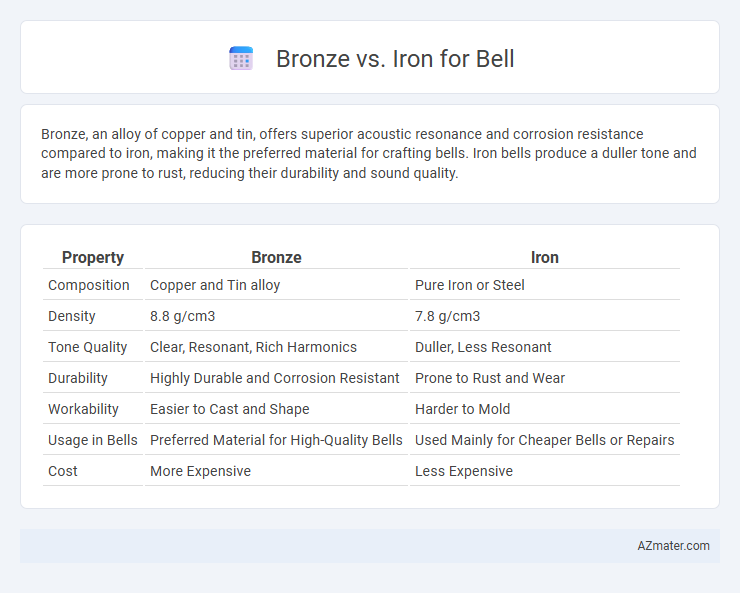Bronze, an alloy of copper and tin, offers superior acoustic resonance and corrosion resistance compared to iron, making it the preferred material for crafting bells. Iron bells produce a duller tone and are more prone to rust, reducing their durability and sound quality.
Table of Comparison
| Property | Bronze | Iron |
|---|---|---|
| Composition | Copper and Tin alloy | Pure Iron or Steel |
| Density | 8.8 g/cm3 | 7.8 g/cm3 |
| Tone Quality | Clear, Resonant, Rich Harmonics | Duller, Less Resonant |
| Durability | Highly Durable and Corrosion Resistant | Prone to Rust and Wear |
| Workability | Easier to Cast and Shape | Harder to Mold |
| Usage in Bells | Preferred Material for High-Quality Bells | Used Mainly for Cheaper Bells or Repairs |
| Cost | More Expensive | Less Expensive |
Introduction to Bell Materials: Bronze vs Iron
Bronze is the preferred material for traditional bells due to its superior acoustic properties, durability, and resistance to corrosion, producing a clear, resonant tone favored in musical and ceremonial applications. Iron, though less common, offers greater strength and cost-effectiveness but generates a duller sound and is more prone to rust, limiting its use primarily to industrial or decorative bells. The composition of bronze, typically 78% copper and 22% tin, enhances vibration quality, making it the industry standard for bell manufacturing.
Historical Use of Bronze and Iron in Bell Making
Bronze has been the material of choice for bell making since ancient times due to its superior acoustic qualities and durability, with notable examples like the Liberty Bell crafted from a bronze alloy consisting primarily of copper and tin. Iron bells emerged later but were less favored because of their inferior sound quality and susceptibility to corrosion, limiting their use primarily to smaller or more economical bells. Historical records show bronze bells were integral to cultural and religious practices worldwide, highlighting the metal's enduring importance in bell manufacturing.
Material Composition and Properties
Bronze bells, typically made from a copper and tin alloy, offer excellent resonance and durability due to their high tensile strength and corrosion resistance. Iron bells, composed primarily of cast iron or wrought iron, are heavier and more brittle, often producing a duller sound with less sustain. The superior acoustic quality and longevity of bronze make it the preferred material in traditional bell casting, while iron is more commonly used for larger, less tonal bells due to its affordability and ease of casting.
Sound Quality: Bronze Bells vs Iron Bells
Bronze bells produce a richer, more resonant sound characterized by complex overtones and sustained vibrations, making them highly favored in musical and ceremonial settings. Iron bells typically emit a sharper, less resonant tone with quicker decay, resulting in a sound that is more metallic and less sonorous. The superior acoustic properties of bronze, due to its alloy composition and density, contribute significantly to the enhanced sound quality compared to iron bells.
Durability and Longevity Comparison
Bronze bells exhibit higher durability due to their corrosion resistance and density, enabling them to withstand weathering and mechanical stress over centuries. Iron bells, although strong, are more prone to rust and structural degradation, reducing their effective lifespan in outdoor environments. The longevity of bronze bells significantly surpasses iron, making bronze the preferred material for lasting acoustic performance and historical preservation.
Cost and Availability of Bronze and Iron
Bronze, an alloy primarily of copper and tin, tends to be more expensive than iron due to the higher cost and limited availability of tin compared to iron ore, which is abundant and widely distributed. The cost of bronze impacts bell manufacturing costs significantly because bronze offers superior durability and acoustic properties, justifying its premium price in quality bells. Iron bells are cheaper to produce but lack the tonal richness and corrosion resistance of bronze, often leading to lower lifespan and sound quality.
Aesthetic Differences Between Bronze and Iron Bells
Bronze bells feature a warm, golden-brown hue with a naturally lustrous finish that enhances their visual appeal in both traditional and modern settings. Iron bells display a darker, matte gray or black patina that often ages with a rustic, industrial charm, lending a stark contrast to brighter environments. The grain and texture of bronze provide smoother reflections, while iron's rougher surface creates a more rugged and utilitarian aesthetic.
Maintenance Requirements for Bronze and Iron Bells
Bronze bells require less maintenance compared to iron bells due to their resistance to corrosion and rust, which minimizes the need for frequent cleaning or protective coatings. Iron bells demand regular upkeep, including sanding, repainting, and rust prevention treatments, to maintain structural integrity and sound quality. Over time, bronze's durability and low susceptibility to environmental damage make it a preferred choice for long-term maintenance efficiency in bell manufacturing.
Cultural and Religious Significance
Bronze bells have historically been favored in many cultures due to their rich, resonant tones which symbolize spiritual harmony and divine presence in religious ceremonies across East Asia and Europe. Iron bells, while less sonorous, often carry cultural significance linked to strength and protection, frequently used in folk rituals and temple architecture in regions like Japan. The choice between bronze and iron for bells reflects not only acoustic preferences but also deep-rooted cultural beliefs about material symbolism in spiritual practices.
Choosing the Right Material: Factors to Consider
Bronze offers superior acoustic resonance and corrosion resistance, making it ideal for bells requiring clear, sustained tones and durability in outdoor environments. Iron, while more affordable and heavier, produces a duller sound and is prone to rust, limiting its use to decorative or temporary installations. Key factors in choosing between bronze and iron bells include sound quality preference, environmental exposure, and budget constraints.

Infographic: Bronze vs Iron for Bell
 azmater.com
azmater.com